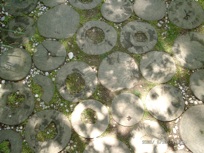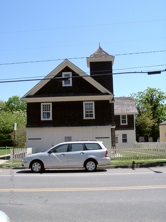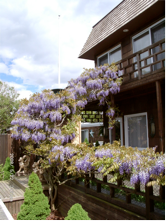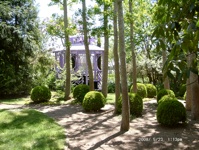arslocii
placeness as art


arslocii
placeness as art




















Quest for artistic endeavor on
Long Island
Not having been further east than Queens before, it was a real treat for us to finally see eastern Long Island, especially after recently re-reading “The Great Gatsby.” If you’re expecting Long Island to be just an extension of New York City, you’ll get over it pretty quickly as the attractive serpentine Robert Moses Causeway takes you through suburban settlements and out into endless sky and low flat land. The landscape is more like the New Jersey coast than anything New Yorkish, but it is dotted by lovely little green towns not far from the upscale beachfront properties as you extend out further from the mainland (yes, it feels like an island, all right). It seems as if anything grows on Long Island, from wine grapes to lush gardens to farms and orchards to scrubby beach grasses. If you are into varying terrain, this part of the East Coast has a mixed bag of offerings. And, to add to the eclectic landscape, a treasure trove of art-meets-wealth.
Sunken Forest
Sailors Haven,
Fire Island, NY
With no preconceived idea about this national seashore park, our ferry ride across the sound was a necessary transition, a time machine really, for the disembarkation and entry into the primeval holly forest (yes, holly). And as you walk along the 1.5 mile boardwalk that ribbons throughout the forest – varying in height above the ground depending on whether you are crossing through a bog, a salt marsh, a thick forest, a swale, or a dune – there is a realization that this is unlike any forest you have seen before. This is a rare maritime forest – one of only a few left intact in the U.S. It is not at all like an eastern hardwood forest that most of us would have had exposure to, since it is largely made up of holly – holly of every shape and size. There is something surreal about it; the atmosphere even feels different, damp and sticky as opposed to cool and filtered, although there are the deeper wooded areas that give more shade but retain the moist sea air. The boardwalk is a marvel, keeping damaging tourist traffic above and away from the forest floor. Whoever conceived of this walkway gets an arslocii nod of integration and harmony.
If you are lucky to have the place to yourself, as we did, there is such quiet and peace in this alternate universe that you can hang onto that time transition and nonexistence for the entire trip. After the darkening and deepening of the foliage, the boardwalk winds up and out into the bright light and grassy, scrubby dunes with open views of water and sky. And if you climb over the higher dunes, voila! the vast Atlantic. Since Fire Island is a barrier island, it is remarkably thin – only about a quarter of a mile across – but you would swear it is much wider because of the way the weaving boardwalk seems to add length and breadth to your journey through the forest and out into the open air. The design and integration of the boardwalk to its site is masterful. Despite it being a viewing platform and protective walkway, it almost blends into its environment, encircles and underscores the varying forest elements and sort of disappears into the sand, like some sort of sea serpent, before it reaches the final protective dunes at land’s end. What then emerges in the swales is a concrete path that, if you follow it east through the dunes, will take you another mile or so, with deer and rabbit sightings (and they are very much okay with your presence), to Cherry Grove – the alternative lifestyle community on Fire Island.
Cherry Grove
Fire Island, NY
After coming out of the forest and the dunes, entering into the town of Cherry Grove, you find yourself in a world unto itself. All sorts of metaphors come to mind, like Neverland and the lost boys, or a western mining town with no women, or Robin Hood and his band living in the forest in tree houses. All the comparisons to fiction are appropriate since it is such a magical place. Imagine the boardwalk described above as replacing all city streets, crisscrossing at intersections with street signs but without traffic signs and floating about four feet above the swampy ground level. (There are no cars on Fire Island except at two bridge-crossings that terminate in parking areas at either end of the island. This town is somewhere in the middle. Ferries only carry passengers, no cars.) Where you go, what you do is done on foot or bicycle. Locals walk around Cherry Grove pulling wagons (Radio Flyers) for shopping or moving goods. There are a few golf carts that haul larger materials and some aged residents who have mobility issues. It’s enchanting. The sense of living in tree houses is enhanced by the boardwalk connecting every house at its front gate with a short gang plank, and also by the dune grasses growing up, lapping at the walkway edges. Some residents have planted trees (street trees?) at ground level below the boardwalk, which reinforces the illusion of being in them. The business district near the ferry dock is minimal: real-estate office, bars and clubs – Welcome to Cherry Grove! At the height of summer fun, it must seem like a gay sailors’ paradise when the ships come in, and there is the question as to why this port didn’t get the Sailors Haven moniker. While waiting for the ferry to return us to the mainland, we watched people resembling anxious immigrants swarming around the boat, waiting to receive their supplies from the mainland or to stow items for the ship to take back to civilization: duffel bags, wagons, carts, TV sets and laundry are hauled on or carried off the ferry, in some ancient past yet timeless activity. Add to this the awesome realization that every stick and stone of every one of the 300 houses in this town had to have arrived in this same way. This wondrous place of refuge and beauty is unlike any place on earth, not only for what it is but for where it is.
Madoo Conservancy
Sagaponack, NY
Nothing of the place is visible from the street as you approach this secret garden, except that you notice what a nice street it is – one of those that you feel uncomfortable parking on because you don’t know if it’s permitted. A little bit of Hampstead in the Hamptons. Walk through a gated and trellised hedge, and there is a dapper gentleman sitting on a bench, near a garden shed, sipping a cool drink and collecting the admission fee. That would be Robert Dash, the creator and bemused proprietor. It is so well worth it, this garden of labored love and artistic vision. Such a nice balance of hardscape to soft, such individualistic designs of multiple garden rooms that would be the envy of other such places (although, really, there are no other such places) – each room strong enough to be the single focal point that other gardens dream of. There is a strong feeling that Alice might have been here, too, in her adventures. Much of the design has classically-based garden ideas for its jumping off point, but it doesn’t stop there. There is a personalization of the motifs that borders on eccentricity, and the flair of the exceptional eye. The exquisite pathways made of wood, stone and brick are rich collages that are details, brushwork of the larger canvas. Structures are referential to serious ideas but are painted for fun in purple, red, yellow and chartreuse. Everything weaves around the stunning 18th-century farm buildings which were built for sustenance and survival and now become quaint artifacts adding to the pleasure of the gardens and providing inspiration and seclusion to the artist within. To visit here is a journey through a life’s work, not merely a garden. With always an eye to the view, either out or in, there is so much going on here that you want to keep looking forever. (And, if you’re lucky, as we were, you might even get invited in for a drink, witty conversation and a bit of Hamptons art history.) Thank you, Robert Dash, for allowing us to enter your private world. (And, BTW, you’re right about LongHouse resembling Trader Vic’s.)
Dan Flavin Art Institute
Bridgehampton, NY
Not huge Dan Flavin fans before this day, we didn’t know what we were in for, but this place is a Dia site and we were now Dia believers (despite not being that wowed by Flavin at Dia: Beacon). This seemed too interesting to pass up – a former firehouse, then a Baptist church, now a permanent art installation. Let’s say our expectations were low to middling about the art. At the entrance level of this unassuming, yet adorable remnant of simpler times in Bridgehampton, the feel of it had such a smaller, humbler scale than the Beacon experience. In fact, the building’s exterior seemed time-unchanged, except for a long, narrow 20th-century industrial down-light that tastefully spanned the width of the front facade and washed over the ground floor’s wooden cladding. A subtle hint of what awaited inside.
The first floor and its open space houses changing exhibits, and the one available for our visit was works on paper by a German artist. Where was the Flavin? The gallery employee pointed up the windy wooden stairwell, like one you might find in an old lighthouse. Wending your way up the stairs, the light’s reflections start to bend around and bounce off all the white-walled surfaces as you approach the large space of the installation. Certainly, you are emerging from the contrasting darker basement area, but the light intensifies as if you are headed into the sun. Once inside the gallery space, there are partitions of drywall built in a connected row, kind of like small office cubicles, running down the length of the building, dividing the long open space into various geometric configurations: some form rectangles, others form 45˚ angles, some are closed off, others have slits or spaces through them – openings into other delineated sections. None of the partitions go all the way to the ceiling, so at first, you think it is a row of exhibits or galleries, each containing some type or other of Flavin’s trademark fluorescent fixtures – some white, some with pastel color. You think to view them as individual unique pieces but then you realize that some of the color from one piece is bleeding through, leaking into and reacting with color from another one, and it dawns on you – this is one large piece and the relationships are purposeful. The light draws you in, it envelops you, it plays on and reacts with every surface, including you. And suddenly you get it – you are walking in and out of a rainbow, this is an experiment in color theory and you are in it, not just viewing it but of it. The work perfectly relates to the space and, when you are there, to you. If it is possible to be embraced by the light of the heavens, then this is it. How appropriate that there is a small room in the back that has some artifacts from the previous incarnation of the church, including some small stained glass windows on the back wall. Some of the colors of the sunlight filtering through the glass panels are what you just walked through in the art installation, perfectly rendered in fluorescent bulbs. Hello, again, arslocii.
Pollock-Krasner House & Studio
East Hampton, NY
Again, we arrived with a preconception of not being enamored of the work of this famous pair of iconic artists from the Abstract Expressionist hall of fame. And here, too, we found another unassuming site. On a country road in a neighborhood called Springs, this charming and staid 1879 farmhouse is not what you might picture as the home that would contain two such grand egos in the artistsphere. On first view, its simplicity of setting and structure doesn’t seem as if it could have reflected the lifestyle of these larger-than-life energetic spirits. After the tour it makes perfect sense. Other than the art on the walls, the living quarters could be grandma’s house. It’s sparely furnished but cozy and inviting, casual and intimate. There is an asceticism about the place. A small clapboard barn several yards from the house is the quietly demure studio. We are ordered to put operating-room booties on over our shoes in a shed-like entry. While we do this we are told the story of how the studio floor had been covered with Masonite after Pollock died. After Krasner’s death, the Masonite was removed and, to everyone’s astonishment, voila! a genuine Pollock-covered floor was revealed. Every drip painting he created in that space was now part of the Milky Way of the floor’s surface. We shuffle into the studio and are hit by the truly moving, ghostly feeling of the space – an inexplicably emotional experience. There is a sadness – possibly of tragically unfinished business, or that of a dog waiting for the return of a master who will never return – and yet there is life there, still. The huge window wall with its single shelf of open paint cans and brushes is like an altar at one end of the large room. And the floor – it is immediately recognizable if you have ever seen a Pollock painting, and it floats somehow: all the layers of paint creating an illusion of depth and it is possible to lose your footing a bit. And there you are, in this space, overwhelmed by such a spiritual feeling, like you are in a sacred place.
Humes Japanese Stroll Garden
Oyster Bay, NY
This is a difficult location to find in a wealthy neighborhood of large, tucked-away estates, with no street parking and tall fences. There is an understated entrance (perhaps once the rear of the property), and a couple of people seated at bridge tables in a gravel parking area wait to collect the admission price. Entering through a bamboo hedge, you find yourself in a wooded glen and proceed to follow a path across a small footbridge above a stream and begin climbing a winding series of stairs, walkways, and stepping stones. As the steep hill ascends, you become aware that you are in a woodland of a different sort ,with Japanese pines, maples, lanterns and water basins. You reach the crest of the hill, close to the original house. Then the path turns and winds back down, taking you through mosses, rocks, ponds, waterfalls and gardens, and to a delightful wooden teahouse near the bottom of the slope. The treasure you find isn’t just a destination so much as it is a journey. But it does transport you, it slows you and it unfolds before you in a sequential and purposeful way. Part of the effect is the terrain – the elevation, the ruggedness, the deep cover of the forest – but it is also the transition into another realm, not only of designed beauty, but also of peace and harmony and of leaving the outside world, well, outside. Far more complex than most labyrinths, it is for walking along a fixed route in a proscribed way that frees the mind and the spirit and allows you to absorb the lovely surroundings. Created by landscape gardeners Douglas and Joan DeFaya for the Humes family, and later rehabilitated by Stephen Morrell, it is more a participatory garden than just a viewing garden, engaging you both physically and spiritually. Small by estate-garden standards at only four acres, it is big in ideas and enjoyment. And it is transformative.
arslocii, a creation of Probasco Haus Press
copyright © 2010 Probasco Haus Press LLC









Left: Dunes area of the Sunken Forest, Fire Island.
Bottom: View of the Secret Garden, Madoo Conservancy, Sagaponack.
Top: Dunes at LongHouse Reserve, East Hampton.












